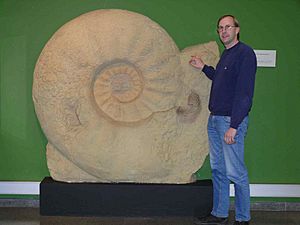Parapuzosia facts for kids
Quick facts for kids Parapuzosia |
|
|---|---|
 |
|
| Parapuzosia seppenradensis with a diameter of 1.8 m (5.9 ft) | |
| Scientific classification |
|
| Kingdom: | Animalia |
| Phylum: | Mollusca |
| Class: | Cephalopoda |
| Subclass: | †Ammonoidea |
| Order: | †Ammonitida |
| Family: | †Desmoceratidae |
| Genus: | †Parapuzosia Nowak, 1913 |
| Type species | |
| Sonneratia daubreei Grossouvre, 1894
|
|
| Species | |
|
|
Parapuzosia seppenradensis was an amazing ancient sea creature. It was a type of ammonite, which were cephalopods. These animals are related to modern-day squids and octopuses. However, ammonites lived inside a cool, coiled shell.
This particular species, Parapuzosia seppenradensis, holds the record for being the largest ammonite ever found! It swam in the oceans a very long time ago. This was during the Cretaceous Period, in areas that are now part of Germany.
Contents
The Giant Ammonite
Parapuzosia seppenradensis is famous because of its incredible size. The largest known fossil of this creature was found in Germany in 1895. Even as a fossil, it measures about 1.8 m (5.9 ft) across! That's taller than most grown-ups!
Scientists believe that if this fossil were complete, the living ammonite would have been even bigger. They estimate it could have been around 2.55 m (8.4 ft) or even 3.5 m (11 ft) wide. Imagine an animal with a shell wider than a small car!
How Big Was It?
If it were alive and complete, this giant ammonite would have been very heavy. Scientists estimate its total live weight was about 1,455 kg (3,208 lb). Its shell alone would have weighed around 705 kg (1,554 lb). That's like a small car or a very large horse!
Life in the Ancient Ocean
Parapuzosia seppenradensis lived during the Lower Cretaceous period. This was a time when dinosaurs roamed the land and many amazing creatures lived in the seas. These ammonites lived in marine environments. This means they lived in the ocean, not in freshwater.
What Happened to Them?
Many ammonite fossils, including those of Parapuzosia seppenradensis, show a common type of damage. The front part of their shell, where the animal lived, is often broken. Scientists think that large sea predators, like giant marine reptiles, might have bitten off this part of the shell. This would have been a way for them to catch and eat the ammonite.
Where Did They Live?
Fossils of Parapuzosia have been found in different parts of the world. This shows that these amazing creatures were spread across ancient oceans. They have been discovered in places that are now:
- Africa
- Europe (like Germany, where the largest one was found)
- North America
This wide distribution tells us that Parapuzosia was a successful group of ammonites. They adapted well to different marine environments during the Cretaceous period.

